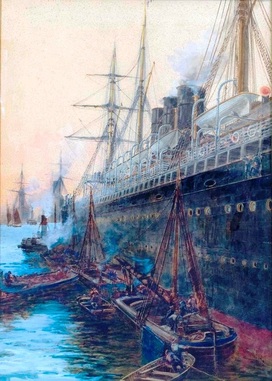Coaling, S S 'City of Rome'
|
Research by Anne Matthews
|
|
Acc No 98
Artist Thomas Greenhalgh Artist dates 1848-1906 Medium watercolour Size 83.8 x 58.4 cm (33 x 23 in) Date painted unknown Inscr: signed (L.R.) Donor Alderman J H Dawson Date donated 22 July 1948 See also 'Amiens Cathedral' by Thomas Greenhalgh |
|
ARTIST
Thomas Greenhalgh is a recognised landscape artist of the Victorian period. Although working mainly in watercolours, his style has been described as that of the ‘English Water School’, he was also skilful in oils. He exhibited widely around the country, including the Walker Art Gallery Liverpool, Manchester City Art Gallery and the Royal Hibernian Academy. There are three of his paintings in the National Collection at the Atkinson Art Gallery, Manchester - In the South Aisle Chartres, Interior of St Marks Venice and The Jubilee Procession Southport. Born in 1848 in Heywood, Lancashire, where his father was a blacksmith, Thomas was the youngest of seven children. By the age of 14 his occupation was already recorded on the census as 'painter', although where he received his training, if any, remains unclear. After his marriage he moved to Southport where he lived until his death in 1906. Here, Thomas immediately associated himself with the local artists, becoming a member of the Southport Art Association and a regular exhibitor at the Southport Spring Exhibition, an annual loan exhibition (1878-1967) run by the Atkinson Art Gallery to spotlight the work of nationally recognised contemporary artists. His work is also included in the Gallery’s permanent collection. A newspaper review of his first exhibits, in 1880, which included the The Lower Falls at Ponty-y-Pair and Upper Falls, remarked on his ‘fine treatment of the foliage in the latter reminding us of the style of Boisserie’. He travelled widely, not just in Britain, which included a time with the Cornwall Artists - From Newlyn to Penzance exhibited in 1890 at the Atkinson Gallery, Manchester - but also to cities in Europe. He seems to have had a passion for churches and painted several views, both interior and exterior. To date over 60 works have been identified online and many of his paintings are available both as prints and posters. Examples of the breadth of his work: View of St Peter’s Basilica from across the Tiber, The Rialto Bridge, Bruges, Westminster Abbey, Houses of Parliament from the River Thames, Tees at Barnard Castle, Richmond Castle from the Swale and the much praised Tropical House, Kew Gardens. His Coaling, "SS City of Rome", in the Mersey forms part of the Lytham St Annes Art Collection. PAINTING The subject of this painting, the SS City of Rome, was an iron hulled steam clipper of the Inman Line launched on 14 June 1881. Whilst often regarded as the most beautiful liner to ever cross the Western Ocean her performance was a major disappointment, mainly regarding speed and cargo capacity, and she was returned to her builders at Barrow-in-Furness after only six voyages. After modifications she was transferred to the Anchor Line where, from 1883, she proved popular on the Liverpool to New York route, carrying 520 first class passengers in quarters of especially high quality along with 810 steerage. She was also one of the first liners lit entirely by electricity. From 1891 she moved to the Glasgow to New York route and later, in 1898 she was chartered to repatriate Spanish naval POWs captured by the USA. The following year she was damaged in a collision with an iceberg but following repairs she was employed in 1900 as a troopship for the Boer War. Returning to transatlantic duty for a short period she was demolished in 1902 by a German scrap firm. There are many images of the SS City of Rome to be found online, the most famous being by Antonio Nicolo Gasparo Jacobsen (1850-1921), the prolific ‘marine’ artist, who painted her no less than 14 times. However, Greenhalgh chose not to provide the viewer with the romantic distant image of a ship riding the waves but instead to focus on the human endeavour required to move her through the water. His love of architectural painting and fine draughtsmanship are mentioned in his obituary and here we can see in sharp detail the upper deck of the ship with its immaculate white lifeboats and rails contrasting with the dark hull and the grimness portrayed in the activity below. As with many of his large subject paintings Greenhalgh includes figures, thus providing not only a sense of proportion but also adding movement and involvement; it is difficult to view this painting without envisaging the heat of the boiler rooms going at full pelt, the smoke already visible. Although on close inspection two figures can be seen balancing on a ledge just on the right above the portholes, and there are even smaller figures observing the scene, the eye remains focused on the numerous small boats and their crews responsible for the ferrying and loading of the coal. Typical of Greenhalgh’s style he limits his choice of colours, keeping the scene sombre. This is enhanced by the unbroken pale yellow washed sky, sunrise perhaps, which we see reflected in the smoke of the small boats and the blueness of the sea, albeit untypical of the Mersey. An automaton of City of Rome, believed to be made in the 1880s as an advertising piece to illustrate the ship to potential passengers, was sold at auction in New Zealand in March 2010 for 7,000 NZ dollars. It featured the ship sailing in front of a revolving backdrop with waves undulating below it and a hot air balloon floating above. |
REFERENCES
http://www.bbc.co.uk/arts/your paintings/collections/ Census records 1851, 1861, 1871, 1901 @ http:/myancestry.co.uk Southport Visiter, 12 February 1880 Southport Visiter, 22 February 1906 http:/www.allposters.co.uk http:/artnet.com/artists/thomasgreenhalgh/past-auction-results Professor D Child OBE, Painters in the Northern Counties of England & Wales (Ed 2001) http://en.wikipedia.org.wiki/sscityofrome |

